






























Airlines, Airports and Airliners 7 March 2024
Google Banner Ad
This Week in Airliner, Airports and Airlines.
IATA - 2023 safest year for flying by several parameters.
Passenger air traffic surpasses pre-pandemic levels.
SAA clarifies perceived runway excursion at OR Tambo.
Updates on Boeing 737-9 MAX Aircraft.
JetBlue and Empire State Development commemorate rebranded terminal 5 skywalk at New York's JFK Airport.
Gulfstream G700 surpasses 50 city-pair speed records.
New Terminal One at JFK breaks ground, begins construction of first phase of development.
Royal Brunei Airlines orders four Boeing 787 Dreamliners.
Worldwide Incidents and accidents.
Bonus video - Micro Aviation's Bathawk at Sue's Place
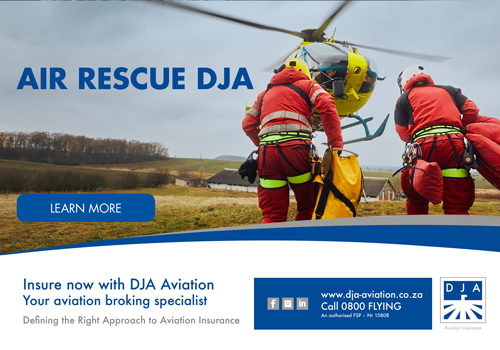

The International Air Transport Association (IATA) released its 2023 Annual Safety Report for global aviation. Aviation continues to make progress on safety with several 2023 parameters showing "best-ever" results.

Report highlights include:
The all-accident rate was 0.80 per million sectors in 2023 (one accident for every 1.26 million flights), an improvement from 1.30 in 2022 and the lowest rate in over a decade. This rate outperformed the five-year (2019-2023) rolling average of 1.19 (an average one accident for every 880,293 flights).
The fatality risk improved to 0.03 in 2023 from 0.11 in 2022 and 0.11 for the five years, 2019-2023. At this level of safety, on average a person would have to travel by air every day for 103,239 years to experience a fatal accident.
IATA member airlines and IATA Operational Safety Audit (IOSA) registered airlines experienced no fatal accident in 2023.A single fatal accident occurred in 2023, on a turboprop aircraft, resulting in 72 fatalities. This is reduced from five fatal accidents in 2022 and an improvement on the five-year average (2019-2023) which was five.
"2023 safety performance continues to demonstrate that flying is the safest mode of transport. Aviation places its highest priority on safety and that shows in the 2023 performance. Jet operations saw no hull losses or fatalities. 2023 also saw the lowest fatality risk and 'all accident' rate on record. A single fatal turboprop accident with 72 fatalities, however, reminds us that we can never take safety for granted. And two high profile accidents in the first month of 2024 show that, even if flying is among the safest activities a person can do, there is always room to improve. This is what we have done throughout our history. And we will continue to make flying ever safer," said Willie Walsh, IATA's Director General.
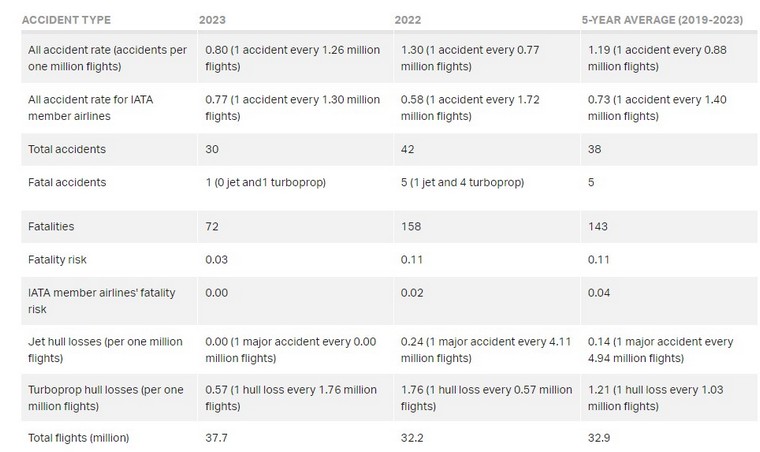
Regional Safety Performance
The 2023 all accident rate improved compared to 2022 for all regions with the exceptions of North America and Asia Pacific. No regions experienced a jet hull loss in 2023. Asia-Pacific recorded a fatal turboprop hull loss, a loss-of-control accident in Nepal in January 2023 with 72 fatalities. As a consequence, all regions except Asia-Pacific recorded a fatality risk of zero in 2023.
North America: The all-accident rate rose from 0.53 per million sectors in 2022 to 1.14 in 2023, but remained better than its 5-year average for the region of 1.21. The largest proportion of accidents in 2023 were related to landing gear collapses.
Asia-Pacific: The all-accident rate increased from 0.56 per million sectors in 2022 to 0.78 in 2023, but was better than the 5-year average for the region of 1.06. The fatality risk rate per million sectors rose for Asia-Pacific operators from 0.00 in 2022 to 0.16, owing to the fatal accident in Nepal in January 2023, which was due to loss of control in flight.
Africa: The all-accident rate improved from 10.88 per million sectors in 2022 to 6.38 in 2023, better than the 5-year average of 7.11. In 2023, there were no fatalities. This region has had no jet hull losses or fatal accidents since 2020. Additionally, 2023 marked the fifth occurrence of Africa reporting zero fatal turboprop accidents, with the first instance recorded in 2015. Under the Focus Africa initiative, IATA introduced CASIP to enhance aviation safety in Africa. CASIP efforts are continuing to partner with states to increase implementation of ICAO Standards and Recommended Practices (SARPs). The Global Aviation Safety Plan (GASP) as well as AFI Regional Aviation Safety Plan for Effective Implementation (EI) of ICAO ISARPs have increased the minimum SARPs implementation threshold to 75% or greater (from 60%). Only 12 of Africa's 54 states meet this new threshold indicating the need for significant improvements.
Middle East and North Africa: The all-accident rate improved from 1.30 accidents per million sectors in 2022 to 1.16 in 2023. It remained slightly higher than the 5-year average of 0.96. While no accidents were related to Global Navigation Satellite System (GNSS) interference, it has emerged as a critical area of concern in the region.
Commonwealth of Independent States: The all-accident rate improved from 2.16 accidents per million sectors in 2022 to 1.09 in 2023. This rate is better than the region's 5-year average of 3.19 accidents per million sectors. Note that CIS sectors may undergo larger revisions than normal once actual flown sectors become available. This will affect accident rate as well as fatality risk calculation.
Europe: The all-accident rate improved from 0.98 per million sectors in 2022 down to 0.48 accidents in 2023. This rate is better than the region's 5-year average of 0.77 accidents per million sectors. The region has had a fatality risk of zero since 2018. The largest proportion of accidents were related to landing gear collapses.
North Asia: The
all-accident rate improved from 0.45 accidents per million sectors in 2022 to 0.00 in 2023. This was better than the region's 5-year average of 0.16 accidents per million sectors. The fatality risk rate improved from 0.23 in 2022 to 0.00 in 2023.
Latin America and Caribbean: In 2023, the region reversed an increase in accidents from the previous year. The all-accident rate per million sectors improved from 4.47 in 2022 to 0.37 in 2023, better than the 5-year average of 1.91.
Jet hull loss rates by region of operator (per 1 million departures)
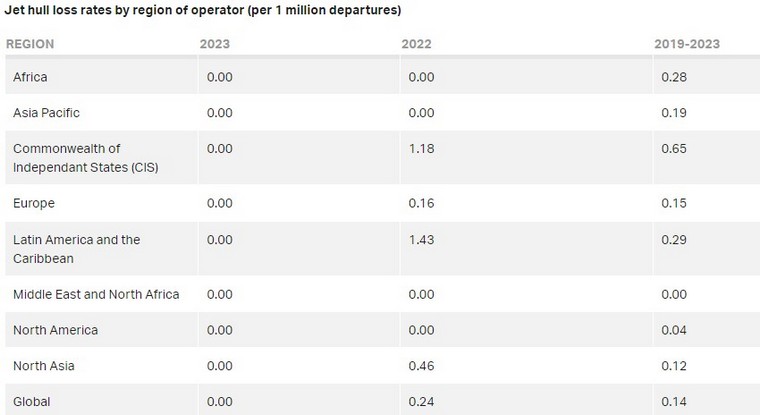
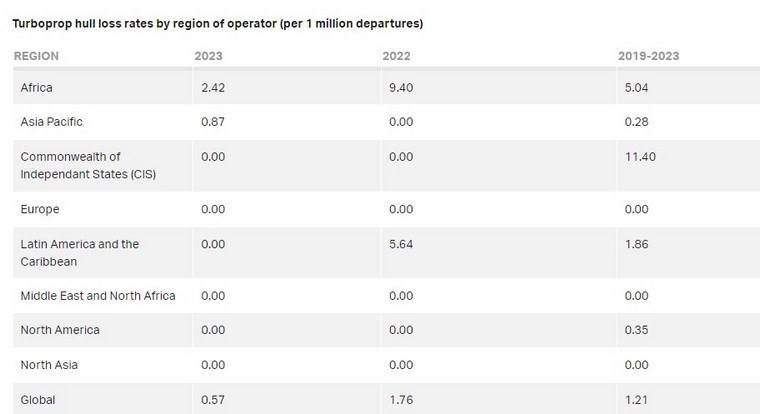
IOSA is the global industry standard for airline operational safety. It is also used by numerous authorities in their regulatory safety programs.
Currently 425 operators are on the IOSA Registry, including 100 non-IATA Members. The all-accident rate for airlines on the IOSA registry in 2023 was 56% better than the rate for non-IOSA airlines (0.69 vs.1.08).
The 2019-2023 average accident rate of IOSA airlines was 0.84 per million sectors which is almost three times better than the non-IOSA average of 2.24. The 19 accidents involving IOSA members led to no hull losses or fatalities.
"IOSA registered carriers recorded no hull losses or fatal accidents in 2023. Since 2005, the all-accident rate for airlines on the IOSA registry is almost three times better than for non-IOSA airlines. This sustained performance demonstrates that the implementation of global standards improves safety. With IOSA's recent transition to a risk-based model focusing on pertinent safety risks while maintaining a baseline of safety, IOSA will become an even more powerful tool to help airlines and regulators to maintain and improve very high levels of safety performance," said Walsh.
Safety as a shared responsibility
A strong safety culture within the aviation industry is essential for continuous improvement in all aspects of operations. Creating an environment that encourages the transparent and timely reporting of incidents and accidents is essential to be able to identify systemic issues and prevent future occurrences. IATA is actively working on two fronts to bolster this effort:
Enhancing Airline Safety Culture: In 2023, IATA introduced The Safety Leadership Charter, designed to reinforce organizational safety culture through airline executives committing to the eight IATA safety leadership principles. To date 45 airlines have signed the charter.
Encouraging States to Provide Timely, Comprehensive and Public Accident Reports: An IATA analysis of accident investigations from 2018 to 2022 showed that just over half are investigated and published as prescribed by the Chicago Convention. The current shortfall in compliance prevents the aviation industry's various stakeholders from accessing vital information that could significantly improve flight safety.
"Safety enhancements and the prevention of future accidents stem from learning from past incidents. For airlines, this means cultivating a robust safety culture where every employee feels accountable for safety and is motivated and expected to report safety-related information. For states, it involves providing timely, comprehensive, and public accident reports. Out of 226 accidents in the past six years, only 121 final accident reports have been made available. This shortfall is not only a blatant disregard for the Chicago Convention but also undermines the safety of our passengers and crew. Governments and their agencies must step up their efforts," said Walsh.
Data Driven Approach
Data for IATA's Annual Safety Report is collected through IATA's Global Aviation Data Management (GADM) programme, the world's most diverse aviation data exchange programme. Data captured in GADM databases comprises accident and incident reports, ground damage occurrences and flight data from more than 470 different industry participants.
"By analyzing data from over 100,000 flights each day, through GADM, IATA is tackling safety issues before they become problems and continuously improving safety. For example, we identified a significant rise in incidents in Global Navigation Satellite System (GNSS) interference which we are now addressing with the help of key regulators such as EASA," said Walsh.


A preliminary assessment by SAA had established that no Runway Incursion occurred, as alluded to, by some media reports. The Air Traffic and Navigation Services (ATNS) has confirmed that the video was a ruse, and the footage had a time lapse of approximately five minutes having passed in just 38 seconds of the recording.
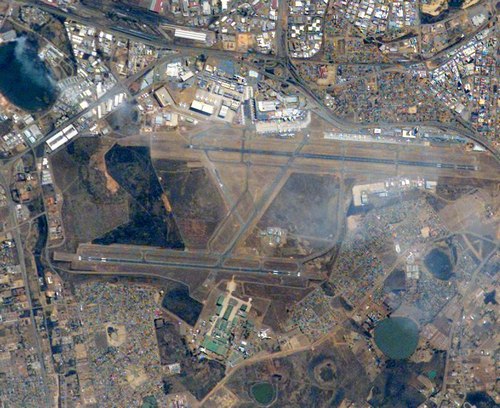
OR TAMBO SAA and its aviation stakeholders employ robust safety measures and implement strategies to mitigate against any potential risk that may arise to passengers and aircraft.
SAA Interim CEO, Prof. John Lamola says, "SAA's flight deck crew are trained routinely to handle all situations that may occur in the air or on the ground, which include runway incursions. SAA confirms that there was no runway incursion or risk of any occurring as shown by the video on social media."

In the first quarter of 2024, ICAO projects that passenger air traffic levels will be around 2% higher than in 2019, with airlines expected to sustain their operating profitability seen in 2023.
"The commitment of ICAO's Member States to aligning their pandemic responses with the guidance developed by the ICAO Council has been crucial to the recovery of their air services," remarked ICAO Council President Salvatore Sciacchitano. "The implementation of ICAO's post-pandemic guidance is now equally crucial to ensuring the resilience and sustainability of this recovery."

Global demand expressed in Freight Tonne-Kilometres (FTK) is forecast to be around 2% below 2019 levels for the full year 2024. This decline is mainly reflective of anticipated reductions in demand due to overall economic weakness worldwide.
"The aspirational goals agreed upon by governments towards the decarbonization of air transport by 2050 are supporting the environmental sustainability of the recovery and future development of the global air transport network," remarked ICAO Secretary General Juan Carlos Salazar. "This is further driven by initiatives led by ICAO to accelerate the development and implementation of the technologies, operational improvements, and cleaner aviation energies that decarbonization requires. ICAO's latest air traffic forecasts are promising for global development and a reminder that the global community must accelerate its sustainability efforts, particularly to assure the production and deployment of sustainable aviation fuels in sufficient quantities."
Today's forecasts come with the caveat that risks affecting international air transport do not escalate from current levels.
ICAO's latest analysis also reveals new insights into aviation for the previous year 2023, revealing that air traffic on most routes had already reached or surpassed pre-pandemic levels by the end of the year. This is aligned with ICAO's earlier prediction of an almost complete recovery of passenger air traffic, namely around 95% of 2019 pre-pandemic levels globally by the end of 2023.
The major regional routes which surpassed the 2019 levels by the end of 2023 are:
• Intra-Europe,
• Europe to/from North America, Middle East, South West Asia and Africa,
• North America to/from Latin America and the Caribbean, South West Asia, South East Asia, and Pacific
• Middle East to/from South West Asia and Africa.
However, most international Asian routes, with the exception of those serving South West Asia, continue to have substantially lower levels of traffic in 2023 compared to the pre-pandemic levels.
Cargo traffic expressed as FTK in 2023 is estimated to be 3% below 2019 pre-pandemic levels reflecting the world economy.
Despite high fuel prices and economic uncertainties, airlines' 2023 total operating profits are estimated at USD 39 billion, in line with the 2019 levels. This profit is mainly due to increased passenger yields and productivity gains achieved by the industry. Similarly, to previous years, airlines of North America and Europe captured the majority of the industry's profits.

During an all-day safety discussion at FAA Headquarters on Tuesday, FAA Administrator Mike Whitaker informed top Boeing officials that the aircraft manufacturer must develop a comprehensive action plan to address its systemic quality-control issues to meet FAA's non-negotiable safety standards.
"Boeing must commit to real and profound improvements," Administrator Whitaker said following the meeting with Boeing Chief Executive Officer and President Dave Calhoun and his senior safety team. "Making foundational change will require a sustained effort from Boeing's leadership, and we are going to hold them accountable every step of the way, with mutually understood milestones and expectations."
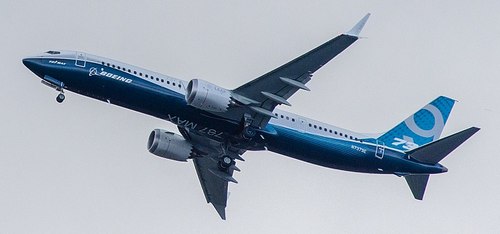
The plan must also include steps Boeing will take to mature its Safety Management System (SMS) program, which it committed to in 2019. Boeing also must integrate its SMS program with a Quality Management System, which will ensure the same level of rigor and oversight is applied to the company's suppliers and create a measurable, systemic shift in manufacturing quality control.
"Boeing must take a fresh look at every aspect of their quality-control process and ensure that safety is the company's guiding principle," Administrator Whitaker said.
Boeing signed the $2.5 billion settlement in relation to the two fatal 737 MAX crashes, and the agreement's terms and conditions had it adopt a compliance program that would prevent it from deceiving regulators.
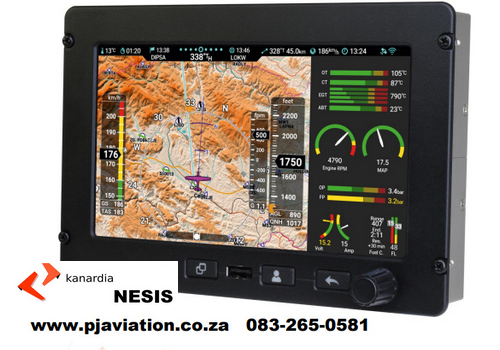

JETBLUE AND EMPIRE STATE DEVELOPMENT COMMEMORATE REBRANDED TERMINAL 5 SKYWALK AT NEW YORK'S JFK AIRPORT
JetBlue takes pride in its role as New York's Hometown Airline and celebrates the success of this partnership alongside Empire State Development and The Port Authority of New York and New Jersey.
The new Skywalk branding incorporates innovative panels designed to enhance visual appeal while showcasing JetBlue's distinctive and dynamic visual identity. In addition to serving as a functional pathway, the branding offers travel tips and destination insights, encouraging JetBlue customers to explore the diverse offerings of New York State. This commitment to New York is evident throughout the redesigned branding, reflecting JetBlue's dedication not only to facilitating seamless travel but also to fostering a sense of pride in the state among its customers.
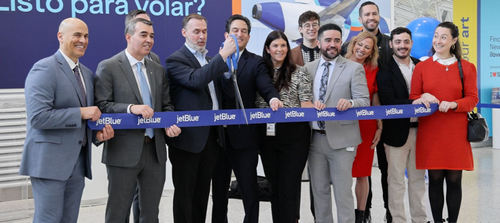
In their long-standing partnership, JetBlue and Empire State Development have consistently spotlighted the cultural richness and allure of New York State and New York City as premier travel destinations. This collaboration has yielded iconic initiatives such as the co-branded logo featuring JetBlue and the renowned "I Love New York'' campaign, introduced in 2010. Building on this foundation, JetBlue unveiled its iconic 'I Heart BLUE York' special livery aircraft in 2011, an enduring symbol of the airline's deep-rooted connection to New York.

Gulfstream Aerospace Corp. today announced the all-new Gulfstream G700 surpassed 50 city-pair speed records en route to the Singapore Airshow.
The G700 achieved its 50th speed record on a carbon-neutral flight connecting Los Angeles to Nice, France, traveling 5,197 nautical miles/9,625 kilometres in 10 hours and 13 minutes at an average speed of Mach 0.90. The industry-leading aircraft then set its 51st speed record - also a carbon-neutral flight - from Nice to Singapore, making the 5,754 nm/ 10,656 km trip in just 11 hours and 30 minutes at an average speed of Mach 0.90.

"These latest records once again prove that the G700 can help our customers reach their destinations faster," said Mark Burns, president, Gulfstream. "We are excited to return to the Singapore Airshow as we continue to see impressive business growth in the Asia-Pacific region. Demand for Gulfstream's high- performance capabilities have never been greater, and we look forward to showcasing our next- generation aircraft, which lead the industry in innovation, performance and cabin comfort."
The G700 features the most spacious cabin in business aviation and has higher than originally announced performance with a maximum range of 7,750 nm/14,353 km at Mach 0.85 and 6,650 nm/12,316 km at Mach 0.90 as well as a maximum operating speed of Mach 0.935, making it the fastest aircraft in the Gulfstream fleet.
The ultralong-range G700 will make its Singapore Airshow debut alongside the award-winning G600 on February 20-25.
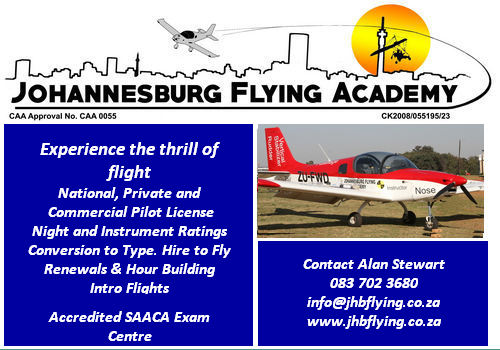
The New Terminal One (NTO)- a consortium of labour, operating and financial partners - today joined a groundbreaking event to inaugurate the official first construction phase of a new world-class terminal at John F. Kennedy International Airport (JFK), along with New York Governor Kathy Hochul, the Port Authority of New York and New Jersey, local elected leaders, key sponsors of the project, Ferrovial, Carlyle, JLC Infrastructure, and Ullico, as well as union leadership and site workers.
With today's groundbreaking, the New Terminal One begins construction of the $9.5 billion, 2.4 million square foot terminal, which is expected to generate over 10,000 total jobs, including more than 6,000 family-sustaining construction positions.
The start of construction follows a revised agreement late last year between the Port Authority and NTO. With Ferrovial becoming a lead sponsor of the project in June, alongside Carlyle, JLC Infrastructure, and Ullico, NTO's financial close became the largest private investment ever committed to a U.S. airport terminal. The innovative partnership and intentionality have made today's announcement a possibility.
Once fully built, the New Terminal One will serve as a global gateway to the New York metropolitan area and aim to set a new standard for world-class design and services. The reimagining of the international passenger experience at JFK generates opportunities for local, minority and women-owned business enterprises, as well as for service-disabled veteran-owned businesses (SDVOB). The state-of-the-art NTO will be the largest international terminal at JFK and is grounded in a commitment to engaging the local southeast Queens community, generating opportunities, and reaching its 30% minority or women-owned business enterprises (MWBE) participation goal with intentionality.
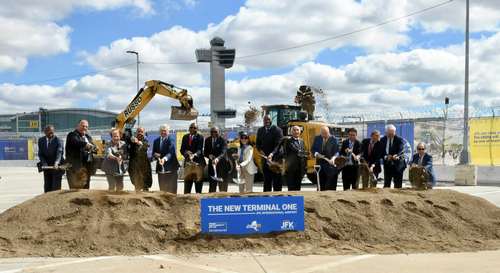
Before commencement of construction, NTO had already contracted with 101 MWBE firms and paid more than $64.7 million for delivering professional services through key engineering, planning, construction, and design work. NTO paid over $46 million to 71 MBE firms and over $18.5 million to 30 WBE firms. The terminal will be built by union labour under a project labour agreement that will generate family-sustaining careers, assist in small business development, and drive workforce participation across Queens and western Nassau Counties.
NTO will be built on the sites of the current Terminal 1, Terminal 2, and the former Terminal 3. NTO will be built in phases, with full completion anticipated by 2030. Sustainably designed and future focused, the terminal will feature expansive, naturally lit public spaces, cutting edge technology, and an array of amenities, all designed to enhance the customer experience and compete with some of the highest-rated airport terminals in the world. With more than 300,000 square feet of dining, retail, lounges, and recreational space, The New Terminal One will remind passengers of everything that makes New York special and offer a uniquely New York sense of place.
"Today marks a historic new chapter for our city, for our state, and for the community of Queens and Southeast Queens in particular," said Dr. Gerrard P. Bushell, Chief Executive Officer of the New Terminal One. "When it is complete, this project will bring a world-class terminal that is sustainably designed and future focused, and a new gateway to the world's greatest city. Through our extensive partnerships with the community and labour, we will seek to drive historically high MWBE participation goals and deliver jobs and real economic opportunity for this community for generations to come. Many thanks to my sponsors for their vision and steadfast commitment to getting this project out of the ground. And to the Port Authority, its staff, and Executive Director Rick Cotton, we thank you, and look forward to continuing our partnership."
Overseen by leading global infrastructure operator Ferrovial, construction and design of the project will be led by AECOM Tishman, which has managed the development of some of the world's most iconic buildings, as well as Gensler, a leading global design and architecture firm. Ferrovial brings 70 years of experience in infrastructure construction, including nearly 25 years of experience investing in, constructing, and managing sustainable, award-winning airports and projects, such as London's Heathrow Airport Terminal 2, Glasgow Aberdeen and Southampton Airports in the United Kingdom, and the Guggenheim Museum in Bilbao, Spain.
JLC Infrastructure, an investment firm, proponent for community engagement, and a strong MWBE partner, has a 30% stake in the project. Ullico, a privately held, labour-owned, insurance and investment company, is driving NTO's labour commitment and is a key project sponsor.


Boeing [NYSE: BA] and Royal Brunei Airlines today announced the airline's purchase of four 787 Dreamliners to renew its widebody fleet. Royal Brunei Airlines' selection of the 787-9 supports the airline's long-term growth strategy, sustainability goals and focus on passenger comfort.
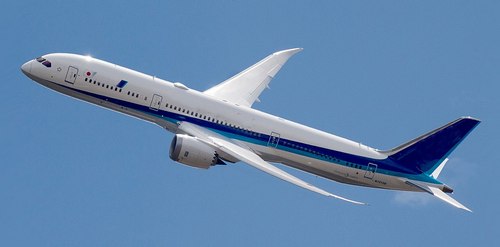
"By renewing its investment in the 787 Dreamliner, Royal Brunei Airlines will continue to connect Brunei with the world while offering the carrier's signature service and comfort to passengers," said Brad McMullen, Boeing senior vice president of Commercial Sales and Marketing. "The 787-9 will deliver the versatility, efficiency and range that Royal Brunei Airlines desires to pursue increasing air travel and tourism opportunities."
Royal Brunei Airlines currently operates five 787-8s, serving destinations in Asia, Australia, the Middle East and the United Kingdom. The 787-9, which can carry nearly 20% more passengers than the 787-8 and fly 14,010 km (7,565 nautical miles), will support the carrier's growing capacity needs on these medium- and long-haul routes.
Boeing's 2023 Commercial Market Outlook forecasts 6.9% annual fleet growth and nearly 4,300 airplanes will be delivered in Southeast Asia over the next 20 years. Royal Brunei Airlines' latest 787 order highlights growing widebody demand in Southeast Asia.
Enhanced comfort features of the 787 family include air that is more humid and pressurized at a lower cabin altitude, as well as technology that counters turbulence. The 787 Dreamliner family also reduces fuel use and emissions by up to 25% compared to the airplanes it replaces.


USA, over Chinle, AZ: While en route to Pittsburgh, an Airbus A220-300 had a confirmed fire in the cabin with smoke due to a thermal runaway of a lithium battery pack. They crew quickly diverted to Albuquerque, New Mexico and landed safely. They taxied to a remote general aviation apron and sat there for multiple hours, supposedly assessing damage and/or deplaning passengers. One passenger was injured by the burning battery as was taken to the hospital.
USA, E of Boston, MA - Atlantic Ocean: An American Airlines Boeing 777-223ER, was en route at Fl370 over the North Atlantic Ocean when cracks in the flight deck windshield forced the crew to divert to Boston Airport, MA (BOS).
USA, Pittsburgh International Airport, PA (PIT/KPIT: A Breeze Airways Airbus A220-300, was struck by lightning. A post flight inspection revealed damage to the vertical stabilizer.

Micro Aviation's Bathawk at Sue's Place

Google Banner Ad
 |
 |
 Copyright © 2024 Pilot's Post PTY Ltd
The information, views and opinions by the authors contributing to Pilot’s Post are not necessarily those of the editor or other writers at Pilot’s Post.
Copyright © 2024 Pilot's Post PTY Ltd
The information, views and opinions by the authors contributing to Pilot’s Post are not necessarily those of the editor or other writers at Pilot’s Post.